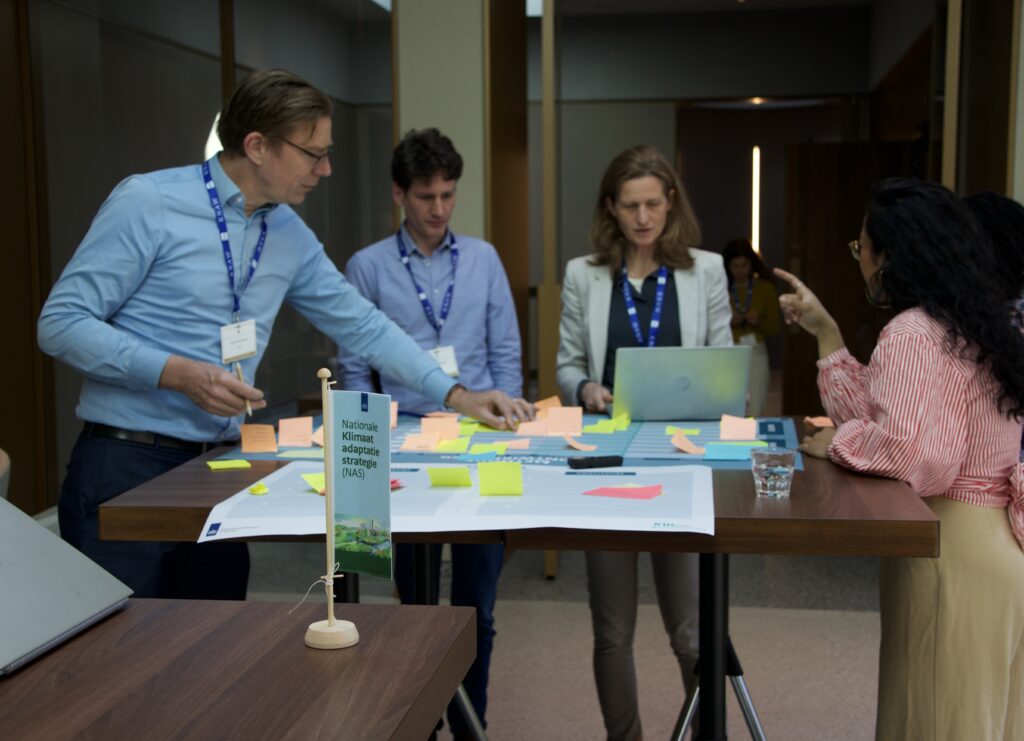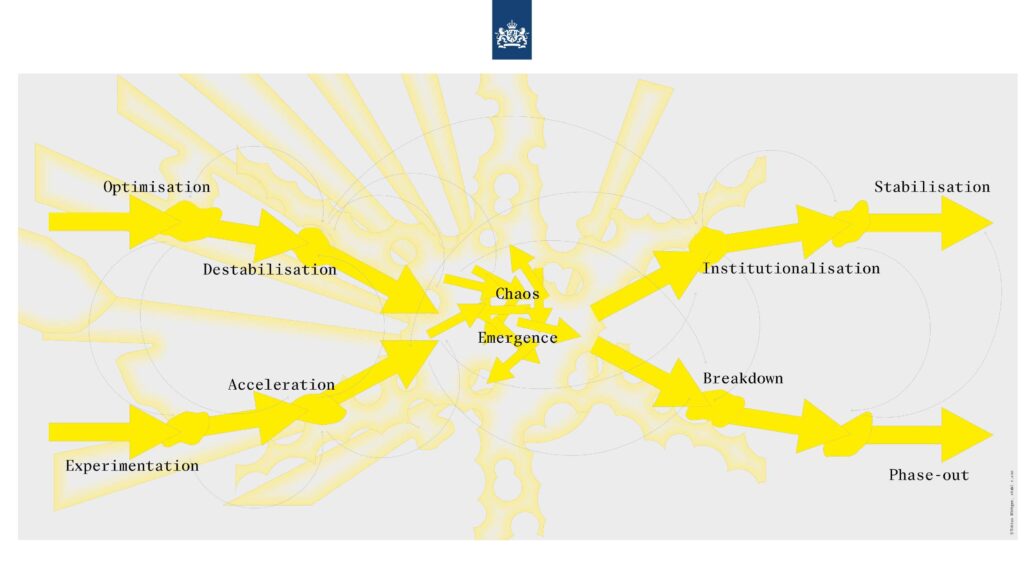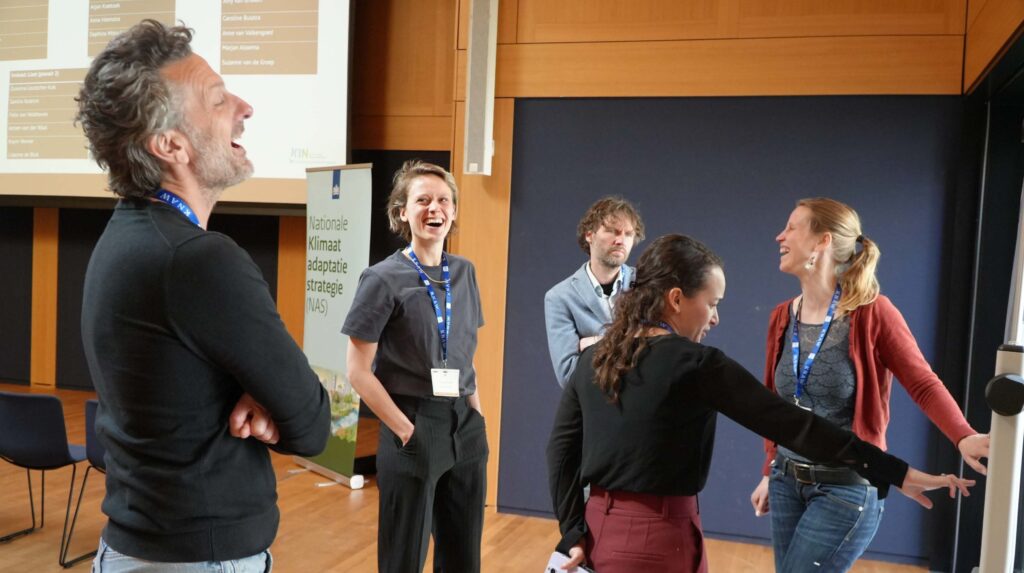What is the social impact of climate policy, for example on health services, access to basic services and culture? That is the central question at two meetings called ‘Social Impact Analysis’ organised by KIN in collaboration with the Ministry of IenW at the Royal Netherlands Academy of Arts and Sciences (KNAW) in April. During the sessions, experts from science and practice will jointly consider the potential social impact of climate policy on the 15 tasks of the National Climate Adaptation Strategy (NAS’26) identified by the Ministry of I&W. The report of these meetings will soon be added to the NAS. In this report, we look back at the second session on 17 April 2025.
(Read the report of the first session here)
What are effects on citizens and society of proposed policies?
Climate adaptation policies have an impact on our citizens and society. This impact is often reflected in PBL or CBS figures but not in concrete (qualitative) terms. The Social Impact Analysis tries to look (far) ahead and make the effects visible so that policymakers can include them in the policy for the National Climate Adaptation Strategy (NAS‘26).
After the opening, Michiel van den Hout (director KIN) briefly explained the purpose of the meeting. That Climate Adaptation policies have social impact is beyond doubt, but what exactly? The results of the meetings will hopefully provide an opportunity to put social impact on the agenda by applying it to the 15 adaptation pathways developed in a series of “Make-atons as part of the NAS, and to develop a good methodology for measuring it – the KIN and the NAS are still pioneering in this respect. The Social Impact Analysis tries to map something in a way that has never been done before.
Work from what you know
The reason the KIN is doing this is because it was created to give science a more important role in accelerating transitions. In addition, KIN wants to support policy scientifically by involving a broad group of people from different backgrounds. That also makes it more complicated, but this kind of transdisciplinary collaborationis badly needed. So there is also a challenge ahead that requires us to tread new paths. Project leader and chair Juliette Boughouf (THRIVE Institute) called on participants today to work from what we do know and how best to use it.
The sound that social impact analysis is often underexposed in policy papers is also heard among participants at the meeting. And that while there is a lot at stake, e.g. equity or how people perceive climate risks.



The SIA methodology for transitions
Derk Loorbach, professor of transition science explains during a brief introduction on the link between the mission of the KIN and transition science that the KIN is thinking about how to use knowledge differently for transitions/system change. Knowledge other than scientific is valuable to include. The question of how to make socially sensitive policies is related to this. What is important here is that we look at how we integrate past insights on social effects into policy beforehand instead of trying to fix it afterwards. Currently, climate adaptation policies are not necessarily developed to achieve a more sustainable and equitable society. Financial aspects are mainly considered. In this respect, a change of policy discourse is needed.


Critical Turning Points
Social Impact Analysis seeks to connect to the technical and quantifiable side of climate issues. This brings methodological challenges. For instance, we have to be careful not to put the method before the cart, deal cleverly with the time perspective, link to critical turning points, interconnect effects and convince from arguments. Thus, an impact story can become the basis for “quantitative” elaboration. This is also the reason why creating support is not included. First, we want to use the method to analyse the impact of the measures. You may then find, for instance, that certain measures have no support base, but do have positive health effects. Then you have to start early to create support, for instance by including people already in the development.

Expert judgement
The first session (read the whole report from last time here) produced 5 themes for the Social Impact Analysis, building on knowledge and existing methods. The session outlined impacts with multidisciplinary experts and looked at analysis methods and data to understand what is already there and what is still missing or where a linkage is missing. The 5 themes are:
- Health
Climate adaptation policies have effects on both mental and physical health, as well as on the perceived state of well-being. - Affordability
Direct or indirect effects on the wallet. Especially with focus on economic impacts on basic services: livelihoods, energy, housing, care and transport. - Access
Effects on accessibility of basic services that can increase inequality in society. In the analysis: the extent to which population groups have access to amenities. - Culture
Effects on our culture. In particular, on our identity, on social cohesion, the dynamics between people and institutions and the freedom felt. - Influence
Effects on the degree of influence a person has. In particular, this concerns one’s own perceived autonomy and about one’s legitimacy.
The session focuses on practising the ‘expert judgement method’. This method comes from the knowledge view from transition science. This states that even though you cannot know everything, you can still have an informed judgement. Participants are asked to name the most important social impact effects in 3 sprints, among others, and to plot them on the 5 themes and adaptation paths. In addition, participants were asked to consider whether there are certain groups in society that will be hit hardest by these impacts. The final sprint asked participants to come up with a shared narrative. Important to note for the workshop participants is that the developed methodology should later be applicable to different contexts. Participants should therefore also keep the Caribbean, for example, in mind.
10 most relevant effects
During the sessions, the main goal is to practice with retrieving relevant effects from each theme. These can later provide the lines of argument to incorporate into the comprehensive report. Effects mentioned in the cultural heritage theme, for example, include that the impact is highly dependent on the context or type of heritage (nature or monument) and that the value we assign to heritage can change over time. When it comes to affordability, one of the issues mentioned is agriculture, which, like our food system, is coming under increasing pressure. Access to food is decreasing and it is becoming more expensive. For resilient nature, we need to engage society early for greater understanding and different perspectives and solutions move from incremental to transformative. It also raises the demand for nature-inclusive policies, also with it also on health and planetary boundaries, and these also require lifestyle adjustments.
Reflection on the session
At the end, participants are asked how they look back on this approach as a means of achieving good social impact analysis and whether it provides compelling input for policymakers. The Social Impact Analysis is seen as enriching for adaptation pathways but the conversation is found to be complicated. How do we get past common sense? How do we even better articulate a scientific rationale? The pathways are very elusive, including in terms of time. One suggestion from the group is to include broad welfare indicators such as those collected by the Social and Economic Council (SER) and Statistics Netherlands (CBS). It is expected that the session will give policymakers much more language to analyse social impact that you don’t take for granted as a professional official. Right now, we still lack the language to invest in a different future. For that, we need to substantiate social impacts much better. Showing opportunities can also motivate making difficult choices.
Next steps
From today’s group, a smaller delegation will continue with input from the session, including to define common themes. More extensive reflection on the sessions will also be requested. The aim is to arrive at a method description for the Social Impact Analysis and the application of the newly developed method to the pathways by a consortium and community testing.

